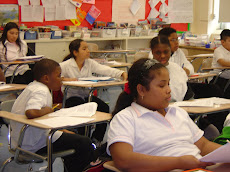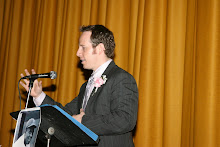Mathematics Scoring Policies
Listed below are the policies to be followed while scoring the Mathematics Tests for all grades. It’s important for all of us to review them so we can become an echo to each other so the information sticks with our students. Please take the time to review all of the following:
1. If the question does not specifically direct students to show their work, teachers may not score any work that the student shows.
2. If a student does the work in other than a designated “Show your work” area, that work may still be scored. (Additional paper is an allowable accommodation for a student with disabilities if indicated on the student’s IEP or 504 Plan.)
3. If the question requires students to show their work, and the student shows appropriate work and clearly identifies a correct answer but fails to write that answer in the answer blank, the student should still receive full credit.
4. If the question requires students to show their work, and the student shows appropriate work and arrives at the correct answer but writes an incorrect answer in the answer blank, the student may not receive full credit.
5. If the student provides one legible response (and one response only), teachers should score the response, even if it has been crossed out.
6. If the student has written more than one response but has crossed some out, teachers should score only the response that has not been crossed out.
7. Trial-and-error items are not subject to Scoring Policy #6 above, since crossing out is part of the trial-and-error process.
8. If a response shows repeated occurrences of the same conceptual error within a question, the student should not be penalized more than once.
9. In questions that provide ruled lines for students to write an explanation of their work, mathematical work shown elsewhere on the page may be considered and scored if, and only if, the student explicitly indicates the work as part of the answer.
10. Responses containing a conceptual error may not receive more than fifty percent of the maximum score.
11. In all questions that provide a response space for one numerical answer and require work to be shown, if the correct numerical answer is provided but no work is shown, the score is 1.
12. In all questions that provide response spaces for two numerical answers and require work to be shown for both parts, if one correct numerical answer is provided but no work is shown in either part, the score is 0. If two correct numerical answers are provided but no work is shown in either part, the score is 1.
13. In all 3-point questions that provide response spaces for two numerical answers and require work to be shown in one part, if two correct numerical answers are provided but no work is shown, the score is 2.
14. For work shown to be considered complete, the final step of the work (bridging the work to the answer) needs to be shown.
Content-Specific Scoring Clarifications for Mathematics Tests
1. All necessary signs of operation should be present for work to be considered mathematically complete and correct. If signs of operation in the work shown are missing but it is absolutely clear and apparent in the student’s work which operation is being used, and if all other work required is correct, the student should receive full credit.
2. In questions that require students to provide bar graphs,
• in all grades, widths of the bars must be consistent
• in all grades, bars must be aligned with their labels
• in all grades, scales must begin at 0, but the 0 does not need to be written
3. If the question asks the student to provide an expression and the student provides an equation, this is an acceptable response in Grades 3 and 4 only.
4. In questions requiring number sentences, the number sentences must be written horizontally.
5. Column subtraction of more than two numbers, while not a preferred procedure, is acceptable, provided that the complete process is shown in the student’s work.
6. Column multiplication of more than two numbers is acceptable beginning in Grade 5, provided that any computation that is not shown falls within the 12 X 12 multiplication table.
7. In pictographs, the student is permitted to use a symbol other than the one in the key, provided that the symbol is used consistently in the pictograph; the student does not need to change the symbol in the key. The student may not, however, use multiple symbols within the chart, nor may the student change the value of the symbol in the key.
8. In estimation items, the estimation must be performed at the beginning of the process; performing exact calculations and then rounding the result of the calculation is not acceptable.
9. The trial-and-error policy applies to Grades 7 and 8 only (and is particularly relevant to algebraic items which require a graphical procedure or in which a variable is to be found). In order for a response to receive full credit, evidence of three trials must be present. A correct answer accompanied by an incomplete trial-and-error procedure can receive only partial credit.
For additional clarification, more information can be found on the Department’s web site at http://www.emsc.nysed.gov/ciai/mst/instructrec.doc.
If you have time, please review these policies with the students. The clarification could really help the students prepare for book 2 next Tuesday. If you have time, please give the students a couple of questions so they can prepare for the test. Even if the previous teacher did the same thing, do it anyway. As I have stated in the past, if we are becoming repetitive with our words to our students then we are most likely doing something right. It’s never too late to prepare our students for the test. If they can take a couple of strategies with them to prepare for the next day or week, it will help them earn a higher score.
May your preparations meet your vision, your colleagues provide information, and no risk blind you from your mission. Have a great week….
ATTENDANCE FOR THE WEEK
Monday: 91%
Tuesday: 88%
Wednesday: 91%
Thursday: 88%
Friday: 89%
Birthdays:
Theresa Stephens March 6th
Kathy Semenick March 11th
Paul Mezan March 11th
Chinyere Emmanuel March 14th
Cheryl White-Grier March 17th
Daniel Foley March 17th
Quote of the Week
“Attempt easy tasks as if they were difficult, and difficult as if they were easy; in the one case that confidence may not fall asleep, in the other that it may not be dismayed. ”
—Baltasar Gracian
Sunday, March 1, 2009
Subscribe to:
Post Comments (Atom)





No comments:
Post a Comment